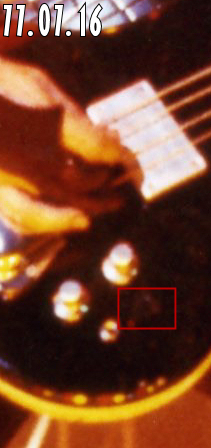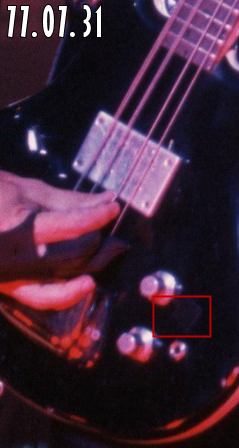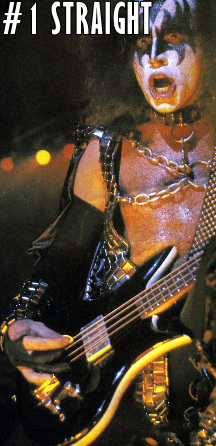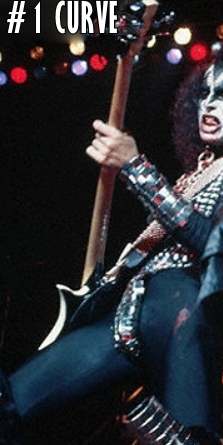


If the LoBue could be considered to have a long and complicated story then the tale of the Spectors is worthy of Sherlock Holmes. According to Gene he met Stuart Spector, then just an upstart luthier working out of a small Brooklyn shop, during the Destroyer sessions. "I just had a guy named Stuart Spector build me one with a longer neck. The body is completely original but based on the concept of an old Gibson Melody Maker. It has a twin horn, small body, with one DiMarzio pickup." [*] The shape of the bass was indeed completely original in that it was custom shaped but it wasn't an original design. At the time Spector only had two model bass guitars, the SB-1 and the SB-2. They both had the same body shape and the number only designated the number of pickups. According to the Spector web site "Gene Simmons of mega-group KISS commissioned several Brooklyn Era SB-1 basses from Stuart in the late 1970's. Some of the modifications included a special gloss black paint job with white binding along the sides of the body. Stuart shaved down the normally bulbous horns of the SB-1 into points."
[*] 1978 Guitar Player interview
What I will refer to as Spector #1 (although in reality it is two basses) makes it debut for the Love Gun tour on the very first night in Halifax. This mk I version shows the "standard" SB-1 controls with one volume and one tone knob (both in silver) and a front output jack (missing is the mini-switch which was standard on the SB-1). The bass(es) were high-gloss black with white trim and a very distinct "point" on the back where the body finish met the unfinished neck (see further down).
Before we delve into the bass(es) conundrum we have to address the fact that throughout the early goings of this tour, Gene never seems to be plugged in. Study the pictures below, the output jack is clearly visible on the front but there is no cord attached in any of the pics. It has been suggested that these bass(es) were built with a secondary output jack on the back, essentially a fairly simple modification, that ran a cord straight to the new Vega wireless system the band began using at the time. So far the photographic evidence of this rear output jack is nowhere to be found. The Spector that is currently in private collector hands after the Butterfields and subsequent auctions has a screwed-on overlay on the back to protect the bass from the extreme wear and tear of the costumes over the years so it doesn't show any rear output jack.
Before we delve into the bass(es) conundrum we have to address the fact that throughout the early goings of this tour, Gene never seems to be plugged in. Study the pictures below, the output jack is clearly visible on the front but there is no cord attached in any of the pics. It has been suggested that these bass(es) were built with a secondary output jack on the back, essentially a fairly simple modification, that ran a cord straight to the new Vega wireless system the band began using at the time. So far the photographic evidence of this rear output jack is nowhere to be found. The Spector that is currently in private collector hands after the Butterfields and subsequent auctions has a screwed-on overlay on the back to protect the bass from the extreme wear and tear of the costumes over the years so it doesn't show any rear output jack.
The Vega wireless system is mentioned in KISS Alive Forever on p. 83.
And then we come to the "how many Spectors" issue. The Spector web site is clear on the matter: "The bass in the photo above [on the Spector web site, not featured here] is still in Gene's possession as far as we know. It was one of three designed in this configuration for Gene." Photographic evidence doesn't allow for three #1 Spectors, there are only two. So the three mentioned is probably two #1's and one #2 (more of which later). Below are pictures detailing the rather slight differences between them. As the photos show there is a marked difference in the shape of the lower horn, most easily seen in the shots of the back. Notice also the triangular "point" of the finish. (And the look of the #1s from behind betrays no evidence of a rear output jack but in all fairness the entire bass isn't visible. What one can argue is that it seems highly unlikely that a rear output jack would be placed on the upper part of the body, far away from the rest of the electronics.)

Modifications soon follow of course. The first two are just simple changing of the knobs. The first change (mk II) is to simple clear lucite knobs with 1-10 numbers on them. The photo shoot at Stuart Air Force base during the rehearsals on 77.11.09 and shots from opening night in Oklahoma City on 77.11.15 show the original silver knobs but by the time the band hits St. Louis on 77.12.02 the new knobs are in place. For this tour Gene also mysteriously starts sporting a cable from the output jack.
The clear knobs make the transition into the new year appearing in Chicago on 78.01.15. After that modification number two kicks in and we see another set of knobs. These are smaller, all black with a small white dot that shows the naught setting (mk III). First seen in Detroit on 78.01.20, these knobs will thankfully stay on for quite some time.
Alas, this leads us to the first major wrench in the Spector story... There are a few pics that don't quite fit in. No matter the angle or lighting, up until now the white binding has been clearly visible at all times. But in the three pictures below I'm having a really hard time seeing a white border. The picture on the left is obviously shot from an upward angle and the bottom of the bass appears all black. The middle shot seems to be shot so that the bottom part of the upper horn is showing but there's no white binding. Plus, I do not like the shape of the lower horn in the middle pic. Straight? Not quite. Curved? No, wouldn't say so. At best it could be described as bulbous...
So, are there three #1's and this all-black version did a few token appearances during the Love Gun/Alive II tours only to be put in mothballs and revived for the Dynasty tour (when the all-black appears "for good")? Or is this just an optical illusion? So far the evidence is scarce for either hypothesis.
So, are there three #1's and this all-black version did a few token appearances during the Love Gun/Alive II tours only to be put in mothballs and revived for the Dynasty tour (when the all-black appears "for good")? Or is this just an optical illusion? So far the evidence is scarce for either hypothesis.

Once we move into 1978 and the Alive II tour the second Spector (henceforth known as Spector #2) makes its first appearance. There are, to my knowledge, precious few pictures of Spector #2 in the Love Gun/Alive II costumes. The pics below are from a show in January, either on the 21st or 22nd. My theory is that this is the third Spector mentioned on the Spector web site (I will more or less ignore the all-black curiosity above for now). It has the same basic hardware as the #1 but a slightly different body shape and a mirror-like pickguard with a jagged lower edge. As far as video evidence goes it first appears in the opening credits of KISS Meets the Phantom of the Park (see below).
The Return of KISS!! The first part of the Dynasty tour shows the Spector #1 mk III hanging in there. Below are a couple of pics from rehearsals and the early part of the tour.




Unfortunately it is exceedingly difficult to try and identify which Spector is which in most photos, even if they are well-lit. Because of this I will "narrate" this story as if there's a single Spector until much later when they are more easily identifiable.
Since this all-black Spector shows up with both sets of replacement knobs it was re-finished early on.
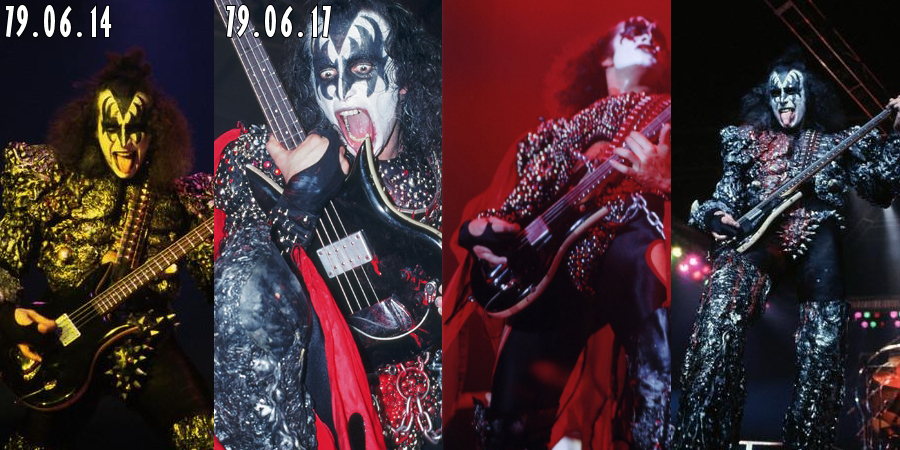
The change to mkIV happens sometime early July: the original pickup is on display during the Largo show 79.07.08 but by the shows in New York there is a new pickup in place. Now, depending on the pic and the angle the new pickup doesn't look quite like itself: at times it looks grayish and with barely discernible pole pieces, and other times it looks black with large and obvious pole pieces. With so little video evidence from this part of the tour it's hard to say whether these are two different pickups or just the trick of light and angles but considering the next (and later) developments I'm going to put my money on the light/angles hypothesis.

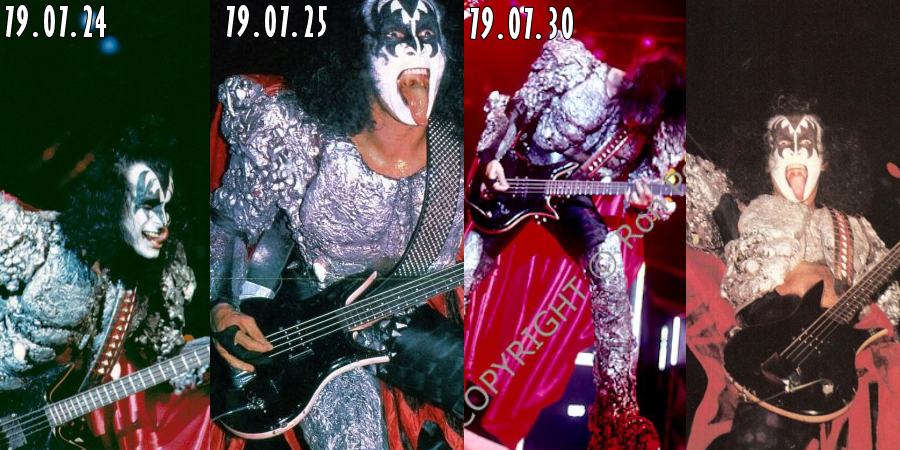
The second change of the Return of KISS tour are actually two changes. First the finish is re-done to be an all-black and Steve Carr makes a headstock inlay of Gene's makeup face. The earliest known date for this is from Uniondale 79.09.01. The shot from Springfield 79.09.05 shows the new inlay. The line-up shot from Knoxville with the slim lower horn has led me to believe that this is a re-finish rather than the re-appearance of the all-black from the Alive II tour. This mkV version stays unmolested for the remainder of 1979, the last photographic evidence being from 79.12.06.



It is generally assumed that the re-finish and the headstock inlay occured at the same time even though the picture evidence can't entirely support that conclusion.
Spector #2 was also a part of the traveling circus that was The Return of KISS but it doesn't seem to have gotten much action. We get an excellent close-up of it in the instrument line-up pic from Knoxville but live shots seem to be lacking. The one below from Cleveland 79.07.19 is the only one I've found that is actually from 1979. (Plenty of 1980 shots are improperly labeled 1979 online. The best indicator when it comes to Gene is the belt part of his cod piece which was leather for the Dynasty tour but got very distinct silvery scales for Unmasked.)

Once the band starts making personell changes at the turn of the decade Gene moves to Spector #2 as his main bass. Spector #1 is certainly still in the picture but when it comes to relative use their fortunes are reversed with #1 "coming off the bench" here and there and #2 getting more stage time.
Spector #1 starts out strong by being featured in the Unmasked tour book. It's then used for the Palladium show on 80.07.25 (the tour book pics were shot the day before) before being relegated to a back-up, making just a few appearances.
Spector #1 starts out strong by being featured in the Unmasked tour book. It's then used for the Palladium show on 80.07.25 (the tour book pics were shot the day before) before being relegated to a back-up, making just a few appearances.
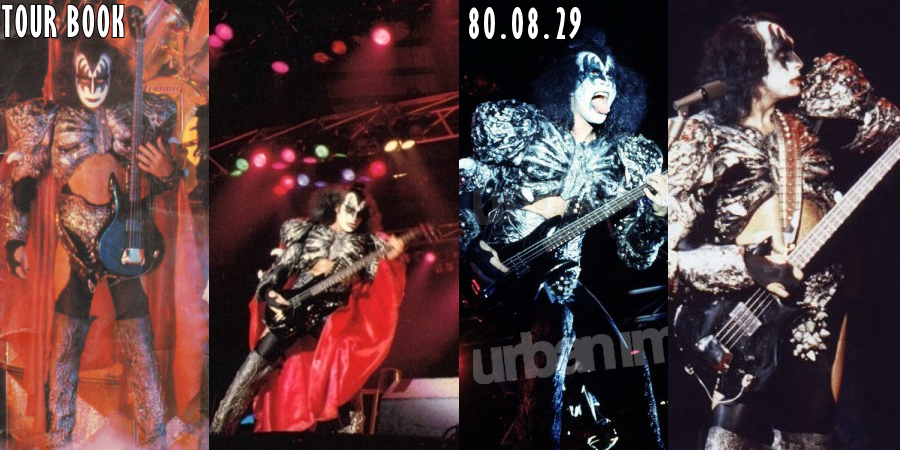
Page 108 of KISS Alive Forever has a nice shot of Spector #1 at the Palladium show.
In contrast, Spector #2 takes a serious beating throughout (the pics below span the entire tour). In a rather unprecedented move the bass is left alone with no noticeable modifications. It even has the original pickup right up to the end of 1980. The video clips are from one of the German dates (the blood spitting clip) and Sydney.


For the 1981 TV appearances in Mexico and the sattelite feed to the San Remo festival Gene relied on the Kramer Axe. But for the Fridays TV appearance in January 1982 Spector #2 was back. The pickup is still the original one as we can see from the lovely closeups.
In the words of Mr. Simmons himself: "Stu Spector made me another bass at the same time, very similar, but the horn on the top was slightly warped and longer than the bottom one" (Guitars that Rule the World, Metal Edge presents KISS Alive 1996)
The one pic I've seen from San Antonio 77.11.22 is inconclusive as far as what knobs are on the bass.

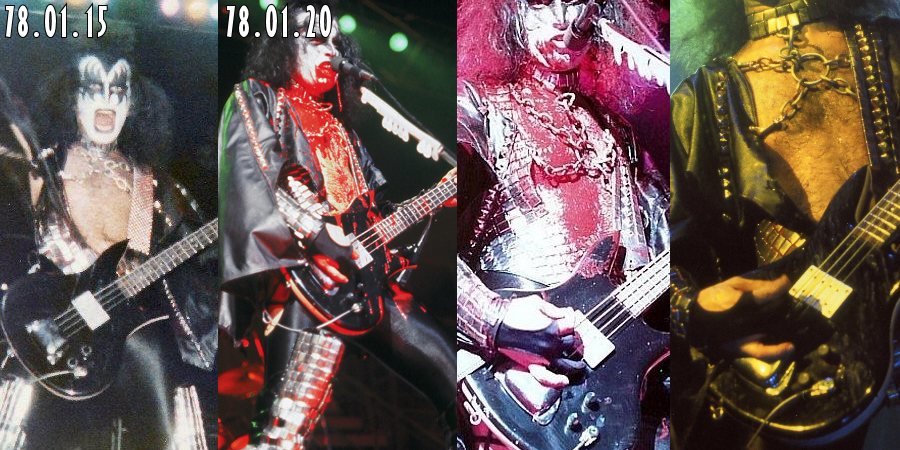
Before we move forward we need to take a step back (and get a little ahead of ourselves) and adress a slight "wrinkle" in the photos. The SB-1 had a mini switch, something that none of Gene's Spectors have and it would be easy to assume that his instruments were simply built without one. In 1977 the most common location of this mini switch was more or less right below the volume knob (with the bass seen in the playing position), and certain pics show what appear to be a piece of tape (or in some cases a dab of paint) covering up something. As seen in the pictures below, all taken from the first month of the Love Gun tour, there is an "irregularity" in the finish below the volume knob that can't be explained by a reflection or a shadow. (It would be easy to assume that it was a shadow cast by, or reflection of, the volume knob but the tone knob shows nothing similar. It is also, when visible, curiously unaffected by lighting conditions. The theory is that this is a simple piece of tape covering up a hole that used to fit a mini switch and the photo from San Diego 77.08.19 even seem to show that hole.
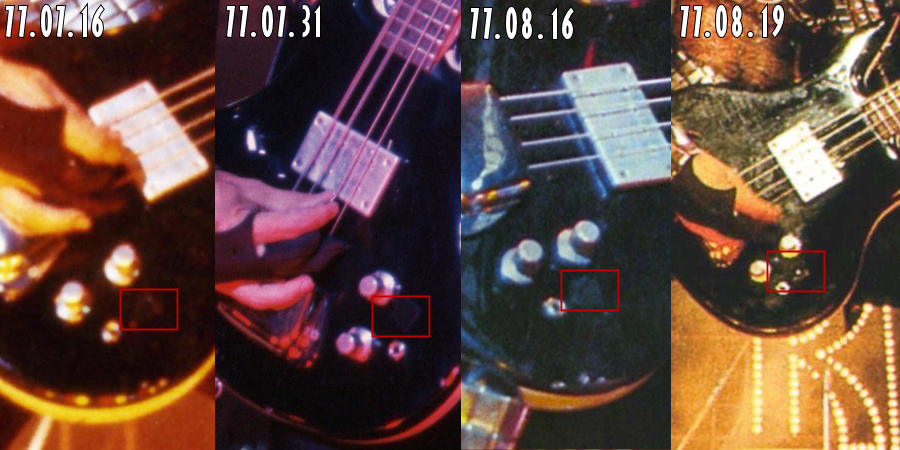
Among the promo pics taken at Stewart Air Force Base 77.11.09 is the photo on the left below which seem to show a hole where the above coverup was placed. The second shot from the Japanese leg of the Alive II tour show that spot seemingly covered up by a small dab of matte paint. This phenomenon can also be spotted at the start of the Return of KISS tour. Here we can see the outline of the tape coverup (check the full-size pic for better detail) for the last time. After the re-finish (more info below) the coverup disappears, most likely because the hole was filled before the finish was applied.

Although I've found nothing to support this the general assumption among those who know far more about early Spectors than I seem to be that the pickup in the mk I was a Model 1.
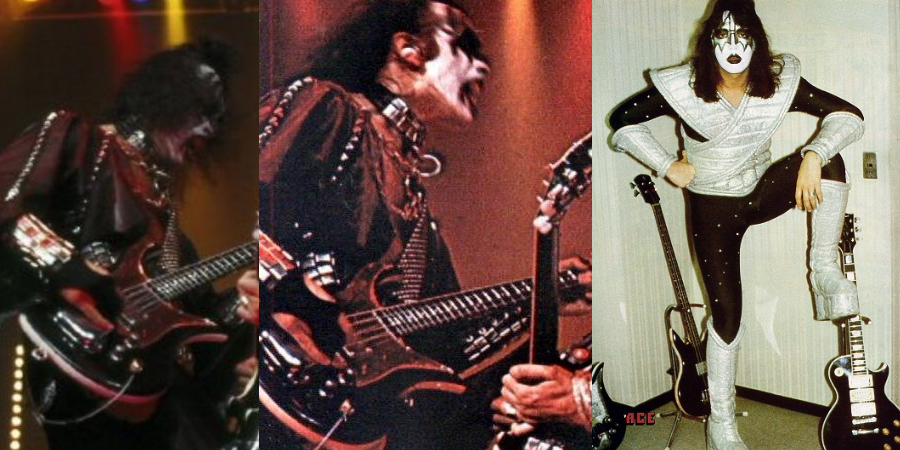
Since this part relies entirely on picture evidence of miniscule details clicking the individual pictures below will bring up higher-res images.
As mentioned in the Axe section this could be considered a comment of sorts on the differing sonic qualities of the two basses. The Kramer Axe was fine for playback but for one of very few live TV performances (the first one since 1974?) the #2 Spector got the nod. Of course, it could also be so simple that the band and management felt that the new, more serious concept album KISS weren't properly represented by an instrument that looked like an Axe.
